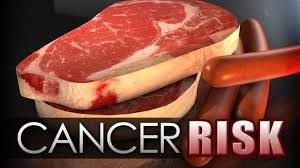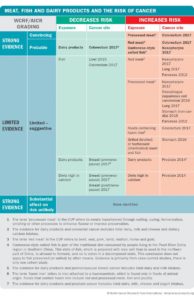
Following on from the previous blog, which looked at how the methods used in processing and preserving your food can ramp up the nasty possibility that one day your doc will mention the ‘C’ word 1 , we’ll look today at the cancer risks involved in eating meat, fish and dairy products.
The Continuous Update Project (CUP), which analyses research on what causes cancer and how it can be prevented, operates under the auspices of the WCRF/AICR (World Cancer Research Fund/American Institute for Cancer Research). The following information is taken from their Third Expert Report 2 released in 2018.
The major findings of this Report are:
- There’s strong evidence that consuming:
- There’s limited evidence that consuming:
- fish DECREASES the risk of liver cancer and colorectum cancer
- red meat INCREASES the risk of nasopharyngeal cancer, lung cancer and pancreatic cancer
- processed meat INCREASES the risk of nasopharyngeal cancer, oesophageal cancer, lung cancer, stomach cancer and pancreatic cancer
- foods containing haem iron INCREASE the risk of colorectal cancer
- grilled or barbecued meat or fish INCREASE the risk of stomach cancer
- dairy products DECREASE the risk of breast (premenopausal) cancer
- dairy products INCREASE the risk of prostate cancer
- diets high in calcium DECREASE breast (premenopausal & postmenopausal) cancer
- diets high in calcium INCREASE prostate cancer
The following is a chart which shows the above information in a more graphic format.

Full details are available at as a downloadable PDF file 3 .

As mentioned above, the salted fish and any processed meats should simply be avoided at all costs – if, that is, you want to do the best you can to avoid cancer risk.
Blog Contents
Mechanisms involved in cancer risk
Red meat and cancer
A number of mechanisms are involved, including:
- cooking meats at high temperatures results in the formation of heterocyclic amines 4 and polycyclic aromatic hydrocarbons 5 , both of which have been linked to colorectal cancer
- haem iron, which is present at high levels in red meat, has been shown 6 to promote colorectal tumorigenesis (the process involved in the production of a new tumour or tumours) by stimulating the endogenous formation of carcinogenic N-nitroso compounds 7
The Report adds: “Polycyclic aromatic hydrocarbons, which are formed when organic substances like meat are burnt incompletely, may also have carcinogenic potential. Grilling (broiling) and barbecuing (charbroiling) meat, fish, or other foods with intense heat over a direct flame results in fat dropping on the hot fire, causing flames; these flames contain polycyclic aromatic hydrocarbons that stick to the surface of food.”
Processed meat and cancer
A number of mechanisms are involved (covered in the previous blog 1 ), including:
- similar to red meat, processed meat is rich in fat 8 , protein 9 and haem iron 6 , which can promote tumorigenesis (the process involved in the production of a new tumour or tumours)
- processed meats are often cooked at high temperatures, which can lead to increased exposure to heterocyclic amines 4 and polycyclic aromatic hydrocarbons 5
- processed meat is invariably higher in fat content than red meat, which may promote carcinogenesis through synthesis of secondary bile acids 10 ; however, the Report suggests that human data only offers weak support of this hypothesis at the moment, with more research being needed
- processed meat is also a source of exogenously derived N-nitroso compounds 11 12 , which may have carcinogenic potential.
Dairy and cancer
A number of mechanisms are involved, including:
- their high calcium content (see below in Joe’s Comments for a discussion of this)
- the lactic acid-producing bacteria in dairy may also be protective 13 14
- casein [the protein in dairy] and lactose [a sugar in dairy] in milk may increase calcium bioavailability
- other nutrients or bioactive constituents in dairy products, such as lactoferrin 15 , vitamin D (from fortified dairy products) or the short-chain fatty acid butyrate [see blog 16 for more on this amazing acid] may also impart some protective functions
The CUP Panel stated that the above require much better research, and that: “…the evidence was generally consistent for dairy products, milk, cheese and dietary calcium, and showed a decreased risk of colorectal cancer with higher consumption.”
Joe’s Comments
The findings on red meat are interesting in relation to cancer risk – basically, there is zero evidence that eating it will help to prevent cancer – indeed, quite the reverse appears to be the case. So why bother with it?
Equally revealing is the evidence about fish (not the Cantonese salted stuff, but just general fish). It may well be that there is some evidence that eating it may protect against two forms of cancer (liver and colorectal), but this doesn’t take into account the other health problems associated with eating fish, covered in an earlier blog 17 . And, in any event, this Report does not look at whether or not you would stand a better chance of avoiding liver and colorectal cancer by dumping fish altogether and eating a whole food plant-based diet instead. This is always the issue with this type of research – the research team always needs to limit their field of enquiry (reductionism vs wholism 18 in order to get funding and draw ‘neat’ conclusions.
Additionally, did you notice the part about foods high in calcium? If you look at the full report 3 , you will see that they are mainly talking about high calcium sources being derived from dairy products – “In countries with high intakes of dairy products, these products are the main source of calcium.” What the Report does not mention (because of milk industry pressure?!) is that dairy consumption is associated with increased rates of osteoporosis/hip fractures and that dairy appears to leach calcium from bones rather than build up bones 19 20 21 22 23 24 25 .
Yes, there are many other studies that suggest that the calcium in dairy is great for your bones, but the very fact that there are good research studies that suggest otherwise makes dairy one more ‘smoking gun’ 26 that does no harm to avoid – especially since, as the report itself states 27 28 , you can get all your calcium from plants 29 30 . In any event, avoid calcium supplements 31 32 .
And this isn’t the only issue to worry about when it comes to dairy products. As the Report authors themselves state:
“The Panel did not base a recommendation on the strong evidence that the consumption of dairy products decreases the risk of colorectal cancer as there is some other evidence that is suggestive of an increased risk of prostate cancer, although that evidence fell below the general threshold required for making a recommendation. For more information on when the evidence is divergent between cancer sites.”
Once more, there always appears to be that ‘smoking gun’ 26 when it comes to animal foods that is simply not an issue when dealing with plant foods.
In the next blog, we will take a quick look at what the Report had to say about the relationship between cancer risk and wholegrains, vegetables and fruit. Want to guess whether they’ll be more factors that decrease or increase cancer risk?

References
- Food Processing & Preserving Causes Cancer [↩] [↩] [↩] [↩]
- WCF/AICR: Meat, fish and dairy products and the risk of cancer [↩]
- WCF/AICR: Meat, fish and dairy products and the risk of cancer. Full PDF report. [↩] [↩]
- Heterocyclic Amines, nutritionfacts.org [↩] [↩]
- Wikipedia definition of polycyclic aromatic hydrocarbons [↩] [↩]
- Plant versus Animal Iron. Written By Michael Greger M.D. FACLM on June 15th, 2017 [↩] [↩]
- WHO: Concise International Chemical Assessment Document 38. N-NITROSODIMETHYLAMINE. First draft prepared by R.G. Liteplo and M.E. Meek, Health Canada, Ottawa [↩]
- What a Single Fatty Meal Can Do to Our Arteries. Written By Michael Greger M.D. FACLM on October 12th, 2017 [↩]
- The Problem with Protein [↩]
- World J Surg Oncol. 2014; 12: 164. Published online 2014 May 24. doi: 10.1186/1477-7819-12-164. PMCID: PMC4041630. PMID: 24884764. Secondary bile acids: an underrecognized cause of colon cancer. Hana Ajouz, Deborah Mukherji, and Ali Shamseddine. [↩]
- Cancer Epidemiol Biomarkers Prev. 2010 Jul; 19(7): 1709–1722. Published online 2010 Jun 22. doi: 10.1158/1055-9965.EPI-10-0225. PMCID: PMC2901412. NIHMSID: NIHMS206690. PMID: 20570910. Dietary Components Related to N-Nitroso Compound Formation: A Prospective Study of Adult Glioma. Robert Dubrow, Amy S. Darefsky, Yikyung Park, Susan T. Mayne, Steven C. Moore, Briseis Kilfoy, Amanda J. Cross, Rashmi Sinha, Albert R. Hollenbeck, Arthur Schatzkin, and Mary H. Ward. [↩]
- Endogenous versus exogenous exposure to N -nitroso compounds and gastric cancer risk in the European Prospective Investigation into Cancer and Nutrition (EPIC-EURGAST) study . Paula Jakszyn Sheila Bingham Guillem Pera Antonio Agudo Robert Luben Ailsa Welch Heiner Boeing Giuseppe del Giudice Domenico Palli Calogero Saieva Vittorio Krogh Carlotta Sacerdote Rosario Tumino Salvatore Panico Göran Berglund Henrik Simán Göran Hallmans María José Sanchez Nerea Larrañaga Aurelio Barricarte María Dolores Chirlaque José R. Quirós Timothy J. Key Naomi Allen Eiliv Lund Fátima Carneiro Jakob Linseisen Gabriele Nagel Kim Overvad Anne Tjonneland Anja Olsen H. Bas Bueno-de-Mesquita Marga O. Ocké Petra HM. Peeters Mattijs E. Numans Françoise Clavel-Chapelon Antonia Trichopoulou Claus Fenger Roger Stenling Pietro Ferrari Mazda Jenab Teresa Norat Elio Riboli Carlos A. Gonzalez
Carcinogenesis, Volume 27, Issue 7, 1 July 2006, Pages 1497–1501, https://doi.org/10.1093/carcin/bgl019 [↩] - Antonie Van Leeuwenhoek. 1999 Jul-Nov;76(1-4):391-4. The role of lactic acid bacteria in colon cancer prevention: mechanistic considerations. Hirayama K, Rafter J.)) ((The role of lactic acid bacteria in colon cancer prevention: Mechanistic considerations Article · Literature Review in Antonie van Leeuwenhoek 76(1-4):391-4 · November 1999. DOI: 10.1023/A:1002099619354 · Source: PubMed [↩]
- Global Cancer Control UICC: Yogurt consumption and risk of colorectal cancer in the Italian European Prospective Investigation into Cancer and Nutrition cohort. Valeria Pala, Sabina Sieri, Franco Berrino, Paolo Vineis, Carlotta Sacerdote, Domenico Palli, Giovanna Masala, Salvatore Panico, Amalia Mattie. [↩]
- Wikipedia: Definition of lactoferrin [↩]
- Butyrate – Why Dietary Fibre is So Important [↩]
- But I thought Fish Was Good For Me! [↩]
- Wholism vs Reductionism – Not Just a War of Words [↩]
- Am J Epidemiol. 1994 Mar 1;139(5):493-503. Case-control study of risk factors for hip fractures in the elderly. Cumming RG, Klineberg RJ. [↩]
- Is Milk Good for Our Bones? Video by Michael Greger M.D. FACLM March 16th, 2015 Volume 23 [↩]
- H A Bischoff-Ferrari, B Dawson-Hughes, J A Baron, J A Kanis, E J Orav, H B Staehelin, D P Kiel, P Burckhardt, J Henschkowski, D Spiegleman, R Li, J B Wong, D Feskanich, W C Willett. Milk intake and risk of hip fracture in men and women: a meta-analysis of prospective cohort studies. [↩]
- D Feskanich, H A Bischoff-Ferrari, A L Frazier, W C Willet. Milk consumption during teenage years and risk of hip fractures in older adults. JAMA Pediatr. 2014 Jan;168(1):54-60. [↩]
- K Michaelsson, A Wolk, S Langenskiold, S Basu, Warensjo Lemming, H Melhus, L Byberg. Milk intake and risk of mortality and fractures in women and men: cohort studies. BMJ. 2014 Oct 28;349:g6015. [↩]
- L A Batey, C K Welt, F Rohr, A Wessel, V Anastasoaie, H A Feldman, C Y Guo, E Rubio-Gozalbo, G Berry, C M Gordon. Skeletal health in adult patients with classic galactosemia. Osteoporos Int. 2013 Feb;24(2):501-9. [↩]
- Phillip A. Study: Milk may not be very good for bones or the body. The Washington Post. October 31, 2014. [↩]
- Animal Foods Are The Smoking Gun [↩] [↩]
- McGee on Food and Cooking: An Encyclopedia of Kitchen Science, History and Culture Hardcover – 8 Nov 2004 by Harold Mcgee. [↩]
- The Penguin Companion to Food, 26 Sep 2002 by Alan Davidson [↩]
- Nutrients. 2012 Aug;4(8):1120-36. Epub 2012 Aug 21. Plant calcium content: ready to remodel. Yang J, Punshon T, Guerinot ML, Hirschi KD. [↩]
- PCRM: Calcium in Plant-Based Diets [↩]
- The Risks and Benefits of Calcium Supplements. Written By Michael Greger M.D. FACLM on March 27th, 2018 [↩]
- Video: Are Calcium Supplements Effective? Michael Greger M.D. FACLM November 18th, 2015 Volume 27 [↩]